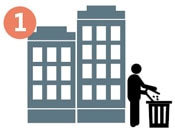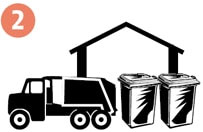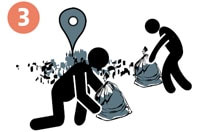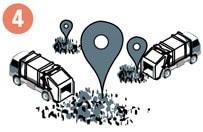Solid Waste Management
A tiny town in West Bengal is turning waste into piles of wealth
The year 1851, regime of East India Company - cholera epidemic broke out in Uttarpara and its surrounding areas. The then Zamindar, Babu Joykrishna Mukherjee and other residents of Uttarpara tried hard to tackle the disease. The epidemic subsided but left Joykrishna thinking - how to stop recurrence of such scourge in future? Progressive and forward looking - as was Joykrishna, immediately understood the value of modern sanitation system and need for germ free drinking water. And who else can ensure these community health standards others than a civic body? Natural thinking, one would say today - but it was a tremendous step forward in mid Nineteenth century Bengal!
The Kolkata project, which includes six municipalities in Hooghly, beat Auckland and Milan to bag the global award for waste management.
A 163-year-old municipality administering a small town in West Bengal has shown the world how to manage solid waste in an eco-friendly way, potentially giving urban planners and administrators the key to tackling one of the biggest civic problems.
The initiatives of Uttarpara-Kotrung municipality helped the Kolkata Solid Waste Management Improvement Project win a global award, defeating nearest contenders Auckland and Milan in urban solid waste management category in the C40 Mayors’ Summit held in Mexico City on December 1,2016. Uttarpara, a 11.71 sq km small city with a population of 1.75 lakh, is one of India’s 415 cities with a population of 1 lakh or more. It also boasts of Asia’s oldest free public library.
The recognition should provide the entire country a reason to rejoice.
With rapid urbanization, the country is faced with a massive waste management challenge. Over 377 million urban people -- 31% of the population -- live in 7,935 towns and cities and generate 62 million tones of municipal solid waste per annum. Only 43 million tonne is collected, 11.9 million is treated and 31 million tonne is dumped in landfill sites.
“Waste generation is estimated to reach 165 million tonne per year by 2030,” as per report of union Govt.
The revised rules of Govt. also ask municipal authorities to channelize the waste to wealth by recovery, reuse and recycle and to integrate rag pickers and waste dealers in the formal system.
A close look at the way the Uttarpara-Kotrung project reveals that the minister may well showcase it as a model, as his grand plan for solid waste management resembles this model closely.
A ride down the streets of Uttarpara – often flanked by palatial 19th and 20th century houses – reveal roadsides and market places that are mostly free of garbage, a common sight in most urban centers. Municipal workers collect bio-degradable and non-degradable solid waste stored in designated bins at households, carry them in vans having separate chambers and dump them separately at the transfer centre.
A group of six women engaged on contract basis as “Social Mobilizer" who visit house to house and check container provided to them for proper segregation and advice all households for proper segregation of waste as bio-degradable and non-bio-degradable.
At this centre, the non-degradable waste is temporarily stored before being compressed in compactor machines and dumped at the sanitary landfill. Here rag pickers who scour vats in the town are seen collecting things for selling to waste dealers. They are provided masks, gloves, gumboots and uniform by the municipality and are required to wear them while sifting through the garbage.
As dumping by the roads stopped, civic authorities engaged more than two dozen rag-pickers at the transfer site. While collecting things, they further segregate whatever bio-degradable waste had remained in the non-degradable lot.
“We are really happy with the new system. We live a cleaner life. Civic authorities are also considering employing us on contractual basis,” said Kapil Bhuniya, a rag-picker.
The bio-degradable waste goes to the adjacent compost plant. The municipality sells the bio-manure produced at the plant named ‘Basudha’from its counter and through marketing agents.
The municipality collects 12-14 tonnes of waste every day and produces 3-4 tonne manure daily. They, however, have the capacity of producing up to 10 tonnes of manure per day.
Uttarpara Kotrung municipality also collects waste from the sewerage system with suction cum jetting machines. “We have a plan to cover all drains across the town,” said civic chief Dilip Yadav who received the award in Mexico City.
According to the website of the C40 group, prior to the project, waste was piled up to 15 meters (50 ft) high at dumping sites, polluting land, water and air in Uttarpara-Kotrung town.
“Poor sewage management and waste dumping in the Ganga River had resulted in the extinction of several hundred aquatic animals and insects, damaging biodiversity… Adoption and promotion of the ‘3R’ principles (reduce, reuse, recycle) has had positive environmental effects, drastically reducing indiscriminate waste dumping in the city,” the website wrote.
REDUCE, REUSE, RECYCLE
UTTARPARA AT A GLANCE
- Area: 11.71 sq km
- Population: 1.75 lakh
- Daily waste collected: 12-14 tonne
- Daily bio-manure produced: 3-4 tonne
- Rag-pickers involved: 25
HOW IT WORKS
Nearly 3-4 tonne manure is produced daily from the collected waste

COLLECTION POINT
Municipal workers collect degradable and non-degradable solid waste stored in designated bins at households. They carry the waste to the transfer centre in vans with separate chambers.

TRANSFER CENTRE
At the transfer centre, non-degradable waste is temporarily stored before being compressed in compactor machines and dumped at the sanitary landfill.

SEGREGATION
Over two dozen rag pickers engaged by the civic bodies collect things for selling to waste dealers. While doing this, they further segregate the left over bio-degradable waste.

RECYCLE
Municipal workers collect degradable and non-degradable solid waste stored in designated bins at households. They carry the waste to the transfer centre in vans with separate chambers.
The Rs 170-crore project involving six civic bodies was funded by Japan International Corporation Agency (JICA) but the funding tenure is scheduled to end in 2017, from when the state government will have to take up funding.


